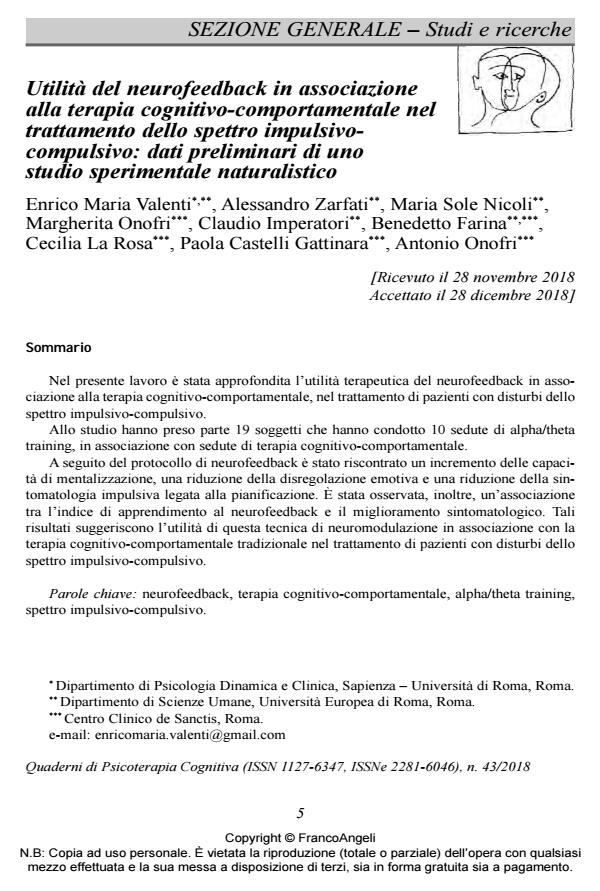Utilità del neurofeedback in associazione alla terapia cognitivo-comportamentale nel trattamento dello spettro impulsivocompulsivo: dati preliminari di uno studio sperimentale naturalistico
Titolo Rivista QUADERNI DI PSICOTERAPIA COGNITIVA
Autori/Curatori Enrico Maria Valenti, Alessandro Zarfati, Maria Sole Nicoli, Margherita Onofri, Claudio Imperatori, Benedetto Farina, Cecilia La Rosa, Paola Castelli Gattinara, Antonio Onofri
Anno di pubblicazione 2019 Fascicolo 2018/43
Lingua Italiano Numero pagine 21 P. 5-25 Dimensione file 117 KB
DOI 10.3280/QPC2018-043001
Il DOI è il codice a barre della proprietà intellettuale: per saperne di più
clicca qui
Qui sotto puoi vedere in anteprima la prima pagina di questo articolo.
Se questo articolo ti interessa, lo puoi acquistare (e scaricare in formato pdf) seguendo le facili indicazioni per acquistare il download credit. Acquista Download Credits per scaricare questo Articolo in formato PDF

FrancoAngeli è membro della Publishers International Linking Association, Inc (PILA)associazione indipendente e non profit per facilitare (attraverso i servizi tecnologici implementati da CrossRef.org) l’accesso degli studiosi ai contenuti digitali nelle pubblicazioni professionali e scientifiche
Nel presente lavoro è stata approfondita l’utilità terapeutica del neurofeedback in associazione alla terapia cognitivo-comportamentale, nel trattamento di pazienti con disturbi dello spettro impulsivo-compulsivo. Allo studio hanno preso parte 19 soggetti che hanno condotto 10 sedute di alpha/theta training, in associazione con sedute di terapia cognitivo-comportamentale. A seguito del protocollo di neurofeedback è stato riscontrato un incremento delle capacità di mentalizzazione, una riduzione della disregolazione emotiva e una riduzione della sintomatologia impulsiva legata alla pianificazione. È stata osservata, inoltre, un’associazione tra l’indice di apprendimento al neurofeedback e il miglioramento sintomatologico. Tali risultati suggeriscono l’utilità di questa tecnica di neuromodulazione in associazione con la terapia cognitivo-comportamentale tradizionale nel trattamento di pazienti con disturbi dello spettro impulsivo-compulsivo.
Parole chiave:Neurofeedback, terapia cognitivo-comportamentale, alpha/theta training, spettro impulsivo-compulsivo.
Enrico Maria Valenti, Alessandro Zarfati, Maria Sole Nicoli, Margherita Onofri, Claudio Imperatori, Benedetto Farina, Cecilia La Rosa, Paola Castelli Gattinara, Antonio Onofri, Utilità del neurofeedback in associazione alla terapia cognitivo-comportamentale nel trattamento dello spettro impulsivocompulsivo: dati preliminari di uno studio sperimentale naturalistico in "QUADERNI DI PSICOTERAPIA COGNITIVA" 43/2018, pp 5-25, DOI: 10.3280/QPC2018-043001